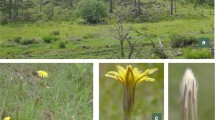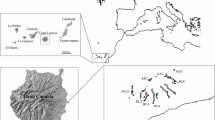Abstract
In order to assess the origins of Antarctic lichens (local or long distance), we examined the population genetic structure of the endemic Antarctic lichen Buellia frigida across a latitudinal gradient of roughly 10° along the Transantarctic Mountains, Western Antarctica, using four microsatellite loci. All loci were highly polymorphic. Data were analysed as both biallelic (dikaryotic) and as haploid in order to determine whether different life-cycle phases could influence our interpretation of population structure. For biallelic data, allelic richness (A) ranged from 5.25 to 7.99 and measures of diversity suggested low levels of gene flow among most sites (e.g. F ST = G ST = 0.09–0.31; D EST = 0.03–0.7). For haploid data, allelic richness (A) ranged from 3.5 to 5.46, private allelic richness (A r) ranged from 0.81 to 2.05, Nei’s unbiased genetic distance ranged from 0.15 to 1.42 and Nei’s unbiased genetic identity ranged from 0.24 to 0.86 among locations. Two locations, the McMurdo Dry Valleys and Queen Maud Mountains, stand out as possible glacial refugia, with both having a high number of private alleles. Despite the high potential for wind-dispersed spores, it appears likely that successful colonisation in different areas is restricted. One possible explanation is that the combination of ice-free conditions and water availability occurs only during the short summer period when the prevailing wind patterns may influence dispersal pathways. Dispersal from the southernmost site (Queen Maud Mountains) appears particularly restricted and may be the result of dispersal barriers such as glaciers. We conclude that a combination of prevailing wind patterns and physical barriers restrict spore settlement and therefore dispersal and recruitment among regions.


Similar content being viewed by others
References
Ackert RP Jr, Kurz MD (2004) Age and uplift rates of Sirius Group sediments in the Dominion Range, Antarctica, from surface exposure dating and geomorphology. Glob Planet Change 42:207–225
Armienti P, Baroni C (1999) Cenozoic climatic change in Antarctica recorded by volcanic activity and landscape evolution. Geology 27:617–620
Armstrong RL (1978) K–Ar dating: late Cenozoic McMurdo volcanic group and dry valley glacial history, Victoria Land, Antarctica. NZ J Geol Geophys 21:685–698
Armstrong RA (1990) Dispersal, establishment and survival of soredia and fragments of the lichen, Hypogymnia physodes (L.) Nyl. New Phytol 114:239–245
Bannister JM, Blanchon DJ (2003) The lichen genus Ramalina Ach. (Ramalinaceae) on the outlying islands of the New Zealand geographic area. Lichenologist 35:137–146
Beck A, Kasalicky T, Rambold G (2002) Myco-photobiontal selection in a Mediterranean cryptogam community with Fulgensia fulgida. New Phytol 153:317–326
Bird CE, Karl SA, Smouse PE, Toonen RJ (2011) Detecting and measuring genetic differentiation. In: Koenemann S, Held C, Schubart C (eds) Phylogeography and population genetics in Crustacea, Crustacean Issues 19 edn. CRC Press, Boca Raton, FL, pp 31–55
Buschbom J (2007) Migration between continents: geographical structure and long-distance gene flow in Porpidia flavicunda (lichen-forming Ascomycota). Mol Ecol 16:1835–1846
Cassie DM, Piercey-Normore MD (2008) Dispersal in a sterile lichen-forming fungus, Thamnolia subuliformis (Ascomycotina: Icmadophilaceae). Botany 86:751–762
Colesie C, Green TGA, Türk R, Hogg ID, Sancho LG, Büdel B (2014) Terrestrial biodiversity trends along the Ross Sea coastline, Antarctica: lack of a latitudinal gradient, controls and potential limits to bioclimatic modeling. Polar Biol 37:1197–1208
Comps B, Gömöry D, Letouzey J, Thiébaut B, Petit RJ (2001) Diverging trends between heterozygosity and allelic richness during postglacial colonization in the European beech. Genetics 157:389–397
Conway H, Hall BL, Denton GH, Gades AM, Waddington ED (1999) Past and future grounding-line retreat of the West Antarctic ice sheet. Science 286:280–283
Crawford NG (2010) SMOGD: software for the measurement of genetic diversity. Mol Ecol Resour 10:556–557
De Wever A, Leliaert F, Verleyen E, Vanormelingen P, Van der Gucht K, Hodgson DA, Sabbe K, Vyverman W (2009) Hidden levels of phylodiversity in Antarctic green algae: further evidence for the existence of glacial refugia. Proc R Soc B Biol Sci 276:3591–3599
Fisher MC, Hanage WP, de Hoog S, Johnson E, Smith MD, White NJ, Vanittanakom N (2005) Low effective dispersal of asexual genotypes in heterogeneous landscapes by the endemic pathogen Penicillium marneffei. PLoS Pathog 1:e20
Fraser CI, Terauds A, Smellie J, Convey P, Chown SL (2014) Geothermal activity helps life survive glacial cycles. Proc Nat Acad Sci 111:5634–5639
Green TGA, Schroeter B, Sancho LG (2007) Plant life in Antarctica. In: Pugnaire FI, Valladares F (eds) Handbook of functional plant ecology, 2nd edn. Marcel Dekker Inc., New York, pp 389–433
Green TGA, Sancho LG, Pintado A, Schroeter B (2011a) Functional and spatial pressures on terrestrial vegetation in Antarctica forced by global warming. Polar Biol 34:1643–1656
Green TGA, Sancho LG, Türk R, Seppelt R, Hogg I (2011b) High diversity of lichens at 84°S, Queen Maud Mountains, suggests preglacial survival of species in the Ross Sea region, Antarctica. Polar Biol 34:1211–1220
Guo J, Liu Y, Wang Y, Chen J, Li Y, Huang H, Qiu L, Wang Y (2012) Population structure of the wild soybean (Glycine soja) in China: implications from microsatellite analyses. Ann Bot 110:777–785
Hall BL, Denton GH (2000) Extent and chronology of the Ross Sea ice sheet and the Wilson Piedmont Glacier along the Scott Coast at and since the last glacial maximum. Geogr Ann Ser A Phys Geogr 82:337–363
Heinken T (1999) Dispersal patterns of terricolous lichens by thallus fragments. Lichenologist 31:603–612
Hewitt GM (1996) Some genetic consequences of ice ages, and their role in divergence and speciation. Biol J Linn Soc 58:247–276
Janetschek H (1967) Arthropod ecology of south Victoria Land. Antarct Res Ser 10:205–293
Jones TC, Green TGA, Hogg ID, Wilkins RJ (2012) Isolation and characterization of microsatellites in the lichen Buellia frigida (Physciaceae), an Antarctic endemic. Am J Bot 99:e131–e133
Jones TC, Wilkins RJ, Hogg ID, Green TGA (2013) Photobiont selectivity for lichens and evidence for a possible glacial refugium in the Ross Sea Region, Antarctica. Polar Biol 36:767–774
Kalinowski ST (2004) Counting alleles with rarefaction: private alleles and hierarchical sampling designs. Conserv Genet 5:539–543
Kalinowski ST (2005) HP:RARE 1.0: a computer program for performing rarefaction on measures of allelic richness. Mol Ecol Notes 5:187–189
Lättman H, Lindblom L, Mattsson J-E, Milberg P, Skage M, Ekman S (2009) Estimating the dispersal capacity of the rare lichen Cliostomum corrugatum. Biol Conserv 142:1870–1878
Leng L, Zhang DEX (2011) Measuring population differentiation using GST or D? A simulation study with microsatellite DNA markers under a finite island model and non-equilibrium conditions. Mol Ecol 20:2494–2509
Lim S, Notley-McRobb L, Lim M, Carter DA (2004) A comparison of the nature and abundance of microsatellites in 14 fungal genomes. Fungal Genet Biol 41:1025–1036
Marchelli P, Gallo LA (2004) The combined role of glaciation and hybridization in shaping the distribution of genetic variation in a Patagonian southern beech. J Biogeogr 31:451–460
Marshall WA (1996) Aerial dispersal of lichen soredia in the maritime Antarctic. New Phytol 134:523–530
McGaughran A, Stevens MI, Hogg ID, Carapelli A (2011) Extreme glacial legacies: a synthesis of the Antarctic springtail phylogeographic record. Insects 2:62–82
McKay R, Dunbar G, Naish T, Barrett PJ, Carter L, Harper M (2008) Retreat history of the Ross Ice Sheet (Shelf) since the Last Glacial Maximum from deep-basin sediment cores around Ross Island. Palaeogeogr Palaeoclimatol Palaeoecol 260:245–261
Meirmans PG, Hedrick PW (2011) Assessing population structure: FST and related measures. Mol Ecol Resour 11:5–18
Muñoz J, Felicisimo AM, Cabezas F, Burgaz AR, Martinez I (2004) Wind as a long-distance dispersal vehicle in the Southern Hemisphere. Science 304:1144–1147
Murtagh GJ, Dyer PS, Crittenden PD (2000) Reproductive systems: sex and the single lichen. Nature 404:564
Nei M (1978) Estimation of average heterozygosity and genetic distance from a small number of individuals. Genetics 89:583–590
Nkuekam GK, Barnes I, Wingfield MJ, Roux J (2009) Distribution and population diversity of Ceratocystis pirilliformis in South Africa. Mycologia 101:17–25
Oberholzer P, Baroni C, Schaefer JM, Oberholzer P, Baroni P, Schaefer JM, Orombelli G, Ochs SI, Kubik PW, Baur H, Wieler R (2003) Limited Pliocene/Pleistocene glaciation in Deep Freeze Range, northern Victoria Land, Antarctica, derived from in situ cosmogenic nuclides. Antarct Sci 15:493–502
Øvstedal DO, Smith RI (2001) Lichens of Antarctica and South Georgia. A guide to their identification and ecology. Cambridge University Press, Cambridge
Peakall R, Smouse PE (2006) Genalex 6: genetic analysis in Excel. Population genetic software for teaching and research. Mol Ecol Notes 6:288–295
Printzen C, Ekman S (2003) Local population subdivision in the lichen Cladonia subcervicornis as revealed by mitochondrial cytochrome oxidase subunit 1 intron sequences. Mycologia 95:399–406
Romeike J, Friedl T, Helms G, Ott S (2002) Genetic diversity of algal and fungal partners in four species of Umbilicaria (Lichenised Ascomycetes) along a transect of the Antarctic peninsula. Mol Biol Evol 19:1209–1217
Rubini A, Paolocci F, Riccioni C, Vendramin GG, Arcioni S (2005) Genetic and phylogeographic structures of the symbiotic fungus Tuber magnatum. Appl Environ Microbiol 71:6584–6589
Sancho LG, Green TGA, Pintado A (2007) Slowest to fastest: extreme range in lichen growth rates supports their use as an indicator of climate change in Antarctica. Flora Morphol Distrib Funct Ecol Plant 202:667–673
Seefeldt MW, Cassano JJ (2008) An analysis of low-level jets in the greater Ross Ice Shelf region based on numerical simulations. Mon Weather Rev 136:4188–4205
Seefeldt MW, Tripoli GJ, Stearns CR (2003) A high-resolution numerical simulation of the wind flow in the Ross Island region, Antarctica. Mon Weather Rev 131:435–458
Ship S, Anderson J, Domack E (1999) Late Pleistocene Holocene retreat of the West Antarctic Ice-Sheet system in the Ross Sea: part 1 geophysical results. Geol Soc Am Bull 111:1486–1516
Stevens MI, Hogg ID (2003) Long-term isolation and recent range expansion from glacial refugia revealed for the endemic springtail Gomphiocephalus hodgsoni from Victoria Land, Antarctica. Mol Ecol 12:2357–2369
Stevens MI, Frati F, McGaughran A, Spinsanti G, Hogg ID (2007) Phylogeographic structure suggests multiple glacial refugia in northern Victoria Land for the endemic Antarctic springtail Desoria klovstadi (Collembola, Isotomidae). Zool Scr 36:201–212
Storey B, Fink D, Hood D, Joy K, Shulmeister J, Riger-Kusk M, Stevens MI (2010) Cosmogenic nuclide exposure age constraints on the glacial history of the Lake Wellman area, Darwin Mountains, Antarctica. Antarct Sci 22:603–618
Strasky S, Di Nicola L, Baroni C, Salvatore M, Baur H, Kubik PW, Schlüchter C, Wieler R (2009) Surface exposure ages imply multiple low-amplitude Pleistocene variations in East Antarctic Ice Sheet, Ricker Hills, Victoria Land. Antarct Sci 21:59
Takahashi T, Tani N, Taira H, Tsumura Y (2005) Microsatellite markers reveal high allelic variation in natural populations of Cryptomeria japonica near refugial areas of the last glacial period. J Plant Res 118:83–90
Walser J (2004) Molecular evidence for limited dispersal of vegetative propagules in the epiphytic lichen Lobaria pulmonaria. Am J Bot 91:1273–1276
Werth S, Wagner HH, Gugerli F, Holderegger R, Csencsics D, Kalwij JM, Scheidegger C (2006) Quantifying dispersal and establishment limitation in a population of an epiphytic lichen. Ecology 87:2037–2046
Acknowledgments
We thank three anonymous reviewers for their valuable comments, P. Ross for advice on diversity statistics, and R. Cursons and O. Patty for helpful advice in the laboratory. Antarctica New Zealand provided logistic support and Helicopters New Zealand, FRST Grant UOWX050, and the University of Waikato provided financial support. C. Beard, L. Sancho, J. Banks, S. Fitzsimmons, R. Seppelt, R. Turk, T. Lumbsch and B. Guzow-Krzeminska provided help in the field and/or laboratory. Lichen samples were transported into New Zealand, under MAF Permit Number 2007032514.
Author information
Authors and Affiliations
Corresponding author
Rights and permissions
About this article
Cite this article
Jones, T.C., Hogg, I.D., Wilkins, R.J. et al. Microsatellite analyses of the Antarctic endemic lichen Buellia frigida Darb. (Physciaceae) suggest limited dispersal and the presence of glacial refugia in the Ross Sea region. Polar Biol 38, 941–949 (2015). https://doi.org/10.1007/s00300-015-1652-9
Received:
Accepted:
Published:
Issue Date:
DOI: https://doi.org/10.1007/s00300-015-1652-9




